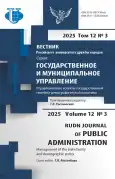The impact of state agglomeration policy on long-term trends of population changes in Russia
- Authors: Sitkovskiy A.M.1
-
Affiliations:
- Institute for Demographic Research, Federal Research Center of the Russian Academy of Sciences
- Issue: Vol 12, No 3 (2025): MANAGEMENT OF THE STATE FAMILY AND DEMOGRAPHIC POLICY
- Pages: 375-385
- Section: MANAGEMENT OF THE STATE FAMILY AND DEMOGRAPHIC POLICY
- URL: https://bakhtiniada.ru/2312-8313/article/view/349662
- DOI: https://doi.org/10.22363/2312-8313-2025-12-3-375-385
- EDN: https://elibrary.ru/BMRMLM
- ID: 349662
Cite item
Abstract
The study analyzes the impact of state agglomeration policy on demographic trends in Russia, with a special focus on the relationship between urbanization and birth rate. The study is based on data on population size and differences in demographic indicators between urban and rural areas, and includes a forecast of possible changes in the demographic situation up to 2100 using scenario modeling methods. The purpose of the study is to identify the key consequences of the agglomeration approach for long-term demographic development in line with the new “Spatial Development Strategy of the Russian Federation for the period up to 2030 with a forecast up to 2036”, as well as to assess possible approaches to adjusting state policy in the context of depopulation. The study materials include Rosstat’s estimated data on population size and components of its change, including total fertility rates for urban and rural populations. Methods of forecasting demographic dynamics components were applied, in particular SARIMA (implemented in Python) for fertility forecasting. The population is projected using the cohort-component method (“age shifting”) with the Spectrum software (DemProj module). Three main scenarios are considered: continuation of the current urbanization trend, maintenance of a static share of urban and rural population, and a “deurbanization” scenario as a possible alternative. The results show that given the current low birth rates and zero migration growth, Russia’s population will continue to decline under all three scenarios. The issue of declining birth rates in cities is particularly acute, exacerbated by the consolidation of agglomerations. It is concluded that the ongoing urbanization policy, combined with low birth rates, intensifies the country’s depopulation, while a deurbanization policy cannot radically change the demographic situation.
About the authors
Arseniy M. Sitkovskiy
Institute for Demographic Research, Federal Research Center of the Russian Academy of Sciences
Author for correspondence.
Email: omnistat@yandex.ru
ORCID iD: 0000-0002-8725-6580
SPIN-code: 9559-1803
Junior Research Fellow, Department of Geo-Urbanistics and Spatial Demography
6 Fotievoy st., bldg 1, Moscow, 119333, Russian FederationReferences
- Grigor’eva EM. SMART methodology. Economic Research. 2023;(1):34–37. (In Russ.). EDN: RGRHUA
- Alekseev AI, Zubarevich NV. A crisis of urbanization and the Russian countryside. Migratsiya i urbanizatsiya v SNG i Baltii v 90-e gody [Migration and urbanisation in the CIS and Baltic States in the 1990s]. Moscow: Tsentr izucheniya problem vynuzhdennoi migratsii v SNG publ.; 1999:83–94. (In Russ.). EDN: VTOSJN
- Bondarenko LV, Arkhangelskiy VN. Demographic situation in rural areas: assessment and prospects. Ehkonomika, trud, upravlenie v sel’skom khozyaistve. 2023;(10):164–176. (In Russ.). https://doi.org/10.33938/2310-164 EDN: UBFNTS
- Bezverbny VA, Maksimov AN. Depopulation trends of rural areas of the Russian Federation according to the Russian census 2020. Nauka. Kul’tura. Obshchestvo. 2022;28(4):150–161. (In Russ.). https://doi.org/10.19181/nko.2022.28.4.12 EDN: DDNZQM
- Vishnevskiy AG, Kvasha EA, Harkova TL, Sherbakova EM. Rural Russia in a demographical study. Universe of Russia. Sociology. Ethnology. 2007;16(1):17–58. (In Russ.). EDN: HYVXEZ
- Iontsev VA, Braga EA. Features of demography processes in rural population of Russian region. Moscow University Economics Bulletin. 2011;(5):73–81. (In Russ.). EDN: ONSYUP
- Medkov VM. Demografiya [Demography]. Moscow: Infra-M publ.; 2007. (In Russ.). EDN: SDPXWX
- Patsiorkovsky VV, Patsiorkovskaya VV. The Russian village: factors of demographic growth. Russia and the Contemporary World. 2010;(3):59–71. (In Russ.). EDN: MWEDFD
- Pivovarov YuL. Urbanizatsiya Rossii v XX veke: idealy i real’nost’ [Urbanisation of Russia in the XX century: ideals and reality]. Geografiya mirovogo razvitiya: sbornik nauchnykh trudov [Geography of world development: Collection of scientific papers]. Moscow: Tovarishchestvo nauchnykh izdanii KMK publ.; 2010:228–239. (In Russ.). EDN: ZCUNJF
- Rybakovsky LL. “Efficiency” as basic index for the state and trends in natality. Sotsiologicheskie issledovaniya. 2016;(4):23–30. (In Russ.). EDN: VZSLIL
- Lappo GM, Lukhmanov DN, Nefedova TG, Polyan PM, Popov RA, Safronov SG, et al. Gorod i derevnya v Evropeiskoi Rossii: sto let peremen [Cities and villages in European Russia: A century of change]. Moscow: OGI publ.; 2001. (In Russ.). EDN: TZWHWT
- Makarov VL, Bakhtizin AR, Sushko ED, Vasenin VA, Borisov VA, Roganov VA. Supercomputer technologies in social sciences: agent-oriented demographic models. Vestnik Rossijskoi akademii nauk. 2016;86(3):252. (In Russ.). https://doi.org/10.18254/978-5-604-5843-7-8 EDN: TNPHBF
- Whelpton PK. Population of the United States, 1925 to 1975. American Journal of Sociology. 1928;34(2):253–270. https://doi.org/10.1086/214667
- Nazarov AA, Nosova MG. The technique of aging in demography and its applications. Tomsk State University Journal of Control and Computer Science. 2009;(3):67–74. (In Russ.). EDN: MNHJOT
- Stover D, Kirmeyer S. DemProj manual: a computer program for making population projections. The Futures Group International; 2007.
- Shimizu S, Shin S. Applicability of SARIMA model in Tokyo population migration forecast. In: Proceedings of the 14th International Conference on Human System Interaction (HSI). Gdańsk; 2021:1–4. https://doi.org/10.1109/HSI52170.2021.9538690
Supplementary files










